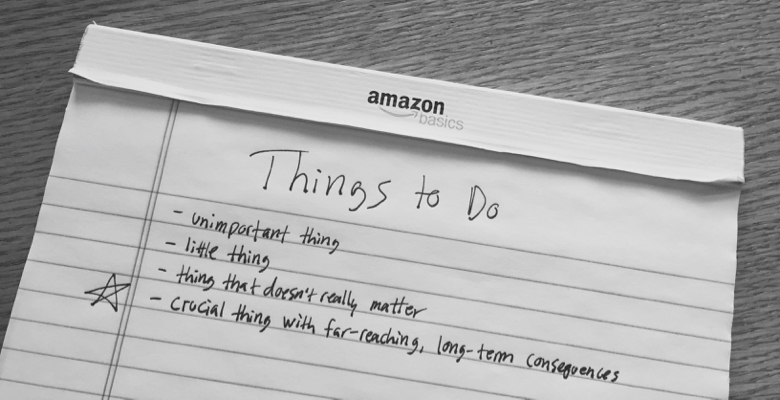Do The Most Important Thing First
 If you’re reading this blog, you probably keep a to-do list of some kind.
If you’re reading this blog, you probably keep a to-do list of some kind.
I’m a big fan of Getting Things Done, of course, but there’s more than one way to skin a cat. Whether you use GTD, a Bullet Journal, a simple to-do list or something else, a single question confronts you every day:
What should I do first?
There are different ways to approach this, and how you choose to answer this question has major implications for how your day unfolds.
The Snowball Method
One option is to knock out several easy tasks first. Like a snowball rolling down a hill, the idea is to build momentum as we go by starting easy:
- answering email
- washing a load of whites
- picking up a book from the library
After we’ve got some momentum, we can attack the big stuff. My wife swears by this method, and I used to subscribe to it myself. I kept running into a problem, though:
It’s easy to spend so much time on easy, minor tasks that we run out of time or energy to do the difficult, important tasks (which are often lengthy, scary, or generally unpleasant).
In other words, I’d rather spend Saturday morning cleaning the house (a series of minor tasks) than doing my taxes. And if I know my taxes are waiting, I’m likely to find more and more minor tasks to do. Like vacuuming behind the couch.
(The tax example is stricly hypothetical, of course. Just a joke. Totally made-up. Hahaha.)
The “How do I feel?” method
Some days, we wake up rarin’ to go. We knock out more before lunch than we usually do in an entire day, and we bulldoze through roadblocks we’d been dealing with for weeks.
Other days, nothing seems to work, and we feel like we’re spinning our wheels. Even getting dressed feels like a chore.
We’re human beings, not robots, and every day can’t be a winner. On the other hand, we can’t wait around for motivation to come to our rescue.
If I feel inspired to sit down and knock out a project in an afternoon, I should take advantage of that state. If I’m having a truly awful day, though, I shouldn’t let myself throw in the towel at lunchtime.
Our approach to productivity needs to be flexible enough to let us harness bursts of motivation without waiting around for them to show up. We can’t give too much heed to how we feel.
The “Do the most important thing first” method
As you can perhaps tell, this is my personal favorite approach.
But it is hard to execute.
One of the first things I do when I get into the office is to look at my “Office” GTD Next Actions list and highlight the most important item. Not the most urgent, the most important. That’s the task I start with.
If I can’t do it right now, I decide when I will be able to do it and put it on my calendar for later in the day. (Note to GTD blackbelts: this bends the GTD rule about the calendar containing only “hard landscape” events, but man, does it work. Other suggestions welcome in the comments!)
Doing the most important thing first is super hard to actually do, and it doesn’t work every time. I still fall back into old habits: spending the entire day essentially treading water, putting out little fires and trying to keep my email at “inbox zero.” Some days I still find myself packing up to go home with my “most important thing” still incomplete.
But this approach works most of the time, and it does wonders for keeping major projects moving forward instead of sitting neglected like old leftovers at the back of the fridge.
Try it, just for today. No commitment. Decide what’s most important, and either do it right now or set a time later in the day to do it (set an alarm on your phone to keep you accountable).
Give it a shot today, and if you like the results, try it again tomorrow.